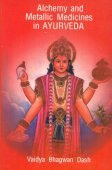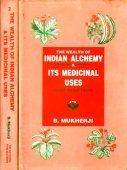Ashtadasha, Aṣṭādaśa, Aṣṭādaśan, Ashtadashan: 24 definitions
Introduction:
Ashtadasha means something in Buddhism, Pali, Hinduism, Sanskrit, the history of ancient India, Marathi. If you want to know the exact meaning, history, etymology or English translation of this term then check out the descriptions on this page. Add your comment or reference to a book if you want to contribute to this summary article.
The Sanskrit terms Aṣṭādaśa and Aṣṭādaśan can be transliterated into English as Astadasa or Ashtadasha or Astadasan or Ashtadashan, using the IAST transliteration scheme (?).
In Hinduism
Shaktism (Shakta philosophy)
Source: Google Books: Manthanabhairavatantram1) Aṣṭādaśa (अष्टादश) or Aṣṭādaśabhujā refers to “she who has eighteen arms” and is used to describe Goddess Tvaritā, according to the Kulakaulinīmata verse 3.77-81.—Accordingly, “Tvaritā is without compare and bestows all accomplishments. [...] Or else, she has eighteen arms [i.e., aṣṭādaśa-bhujā] and one should think (of her when engaged) in magical rites. She wears golden clothes and is adorned with a peacock banner. She sits on a lion throne, bestows boons and holds a peacock parasol. She has a peacock bangle and is adorned with a garland of wild flowers. She is adorned with a beautiful peacock diadem”.
2) Aṣṭādaśa (अष्टादश) or Caryāṣṭādaśa refers to the “eighteen practices”, associated with the Goddess Kulālikā (of five faces) and the Kṛta Age, according to the Manthānabhairavatantra, a vast sprawling work that belongs to a corpus of Tantric texts concerned with the worship of the goddess Kubjikā.
3) Aṣṭādaśa (अष्टादश) or Aṣṭādaśanātha refers to the “(sequence of the) eighteen Nāthas”, according to the Ṭīkā (commentary) on the Manthānabhairavatantra.—[...] The Ṭīkā, which refers to the Divine Current as the Sequence of the Bliss of the Command, glosses it as the Sequence of the Eighteen Nāthas (aṣṭādaśanātha-krama) who are the teachers of the Convention of the Flower.

Shakta (शाक्त, śākta) or Shaktism (śāktism) represents a tradition of Hinduism where the Goddess (Devi) is revered and worshipped. Shakta literature includes a range of scriptures, including various Agamas and Tantras, although its roots may be traced back to the Vedas.
Jyotisha (astronomy and astrology)
Source: Wisdom Library: Brihat Samhita by VarahamihiraAṣṭādaśa (अष्टादश) refers to “eighteen (months)”, according to the Bṛhatsaṃhitā (chapter 11), an encyclopedic Sanskrit work written by Varāhamihira mainly focusing on the science of ancient Indian astronomy astronomy (Jyotiṣa).— Accordingly, “Cala Ketu is a comet which appears in the west with a tail an inch in length pointing to the south; as it proceeds more and more towards the north, it increases in length. After touching the Pole star or the constellation of Abhijit, it turns back and after travelling one half of the sky disappears in the south. When this Ketu appears, the country between Prayāga (Allahabad) and Avantī, the forests near Puṣkara, the north, the country of Devikā and Madhyadeśa will perish. The other countries will also suffer in several places from disease and from famine; the effects described will last for 10 months according to some and for 18 months [i.e., aṣṭādaśa] according to others”.

Jyotisha (ज्योतिष, jyotiṣa or jyotish) refers to ‘astronomy’ or “Vedic astrology” and represents the fifth of the six Vedangas (additional sciences to be studied along with the Vedas). Jyotisha concerns itself with the study and prediction of the movements of celestial bodies, in order to calculate the auspicious time for rituals and ceremonies.
Shaivism (Shaiva philosophy)
Source: SOAS University of London: Protective Rites in the Netra TantraAṣṭādaśa (अष्टादश) refers to the “eighteen elements”, according to the Netratantroddyota commentary on the Netratantra of Kṣemarāja: a Śaiva text from the 9th century in which Śiva (Bhairava) teaches Pārvatī topics such as metaphysics, cosmology, and soteriology.—Accordingly, [verse 4.1-2ab]—“[The thirty-six [are those] beginning with earth and ending with śiva [i.e., the complete set of thirty-six tattvas]. That halved, the eighteen elements (aṣṭādaśa-bhūta) [beginning with] the five elements [pṛthvi, āpas, agni, vāyu, ākāśā], prakṛti, puruṣa, rāga, niyati, vidyā, kāla, kalā, māyā, śuddhavidyā, īśa, sadāśiva, śakti, and śiva. [...]”.

Shaiva (शैव, śaiva) or Shaivism (śaivism) represents a tradition of Hinduism worshiping Shiva as the supreme being. Closely related to Shaktism, Shaiva literature includes a range of scriptures, including Tantras, while the root of this tradition may be traced back to the ancient Vedas.
Yoga (school of philosophy)
Source: ORA: Amanaska (king of all yogas): A Critical Edition and Annotated Translation by Jason BirchAṣṭādaśan (अष्टादशन्) refers to “eighteen (days)”, according to the Amanaska Yoga treatise dealing with meditation, absorption, yogic powers and liberation.—Accordingly, as Īśvara says to Vāmadeva: “[...] [Now], I shall define the nature of that highest, mind-free absorption which arises for those devoted to constant practice. [...] If [the Yogin] who abides in absorption remains [in it] up to the end of eighteen days (aṣṭādaśa-dina), he obtains the Siddhi called Garimā, by which he possesses the weight of the earth. [...]”.

Yoga is originally considered a branch of Hindu philosophy (astika), but both ancient and modern Yoga combine the physical, mental and spiritual. Yoga teaches various physical techniques also known as āsanas (postures), used for various purposes (eg., meditation, contemplation, relaxation).
In Buddhism
Mahayana (major branch of Buddhism)
Source: academia.edu: A Study and Translation of the GaganagañjaparipṛcchāAṣṭādaśa (अष्टादश) refers to the “eighteen (special qualities)”, according to the Gaganagañjaparipṛcchā: the eighth chapter of the Mahāsaṃnipāta (a collection of Mahāyāna Buddhist Sūtras).—Accordingly, “How then, son of good family, does the Bodhisattva appear to many beings performing the deeds of a Buddha (buddhakārya) even when the Buddhas do not appear? Son of good family, (1) the Bodhisattva has perfected the purification of the ten powers by knowing what is proper and what is improper; (2) he has perfected the purification of the four fearlessness by knowing the cessation of impurities; (3) he has perfected the purification of the eighteen special qualities (aṣṭādaśa-āveṇika-buddhadharma) of the Tathāgata by knowing the unattached knowledge of the three times; [...]”.

Mahayana (महायान, mahāyāna) is a major branch of Buddhism focusing on the path of a Bodhisattva (spiritual aspirants/ enlightened beings). Extant literature is vast and primarely composed in the Sanskrit language. There are many sūtras of which some of the earliest are the various Prajñāpāramitā sūtras.
Tibetan Buddhism (Vajrayana or tantric Buddhism)
Source: OSU Press: Cakrasamvara SamadhiAṣṭādaśan (अष्टादशन्) refers to “eighteen (arms)”, according to the Cakrasaṃvara Samādhi [i.e., Cakrasamvara Meditation] ritual often performed in combination with the Cakrasaṃvara Samādhi, which refers to the primary pūjā and sādhanā practice of Newah Mahāyāna-Vajrayāna Buddhists in Nepal.—Accordingly, “By the form of a skull cup, and by the letter Māṃ, Vāruṇī, Eighteen arms (aṣṭādaśan-bhūja), one face, red color, and three eyes, A sword, arrow and hook, on the right, a skull cup, ax and banner, Thus a mace, thus a bell, and in the ninth, granting wishes, A two-headed drum, a bow and noose, a staff and a water pot, A trident, hammer and lute, and thus a number, in the upper hand, A young adolescent beauty, a great beauty, a beautiful goddess”.

Tibetan Buddhism includes schools such as Nyingma, Kadampa, Kagyu and Gelug. Their primary canon of literature is divided in two broad categories: The Kangyur, which consists of Buddha’s words, and the Tengyur, which includes commentaries from various sources. Esotericism and tantra techniques (vajrayāna) are collected indepently.
India history and geography
Source: Cologne Digital Sanskrit Dictionaries: Indian Epigraphical GlossaryAṣṭādaśa.—cf. aṣṭādaśa-jāti-parihāra (IE 8-5); literally, ‘eighteen’; actually, ‘all’ (Ep. Ind., Vol. XXX, p. 115). Cf. Od8iyā aṭhara-gaḍajāta (EI 26). See aṣṭa, ṣaṭtriṃśat, ṣaṭpañcāśat, bāhattara, etc. Note: aṣṭādaśa is defined in the “Indian epigraphical glossary” as it can be found on ancient inscriptions commonly written in Sanskrit, Prakrit or Dravidian languages.

The history of India traces the identification of countries, villages, towns and other regions of India, as well as mythology, zoology, royal dynasties, rulers, tribes, local festivities and traditions and regional languages. Ancient India enjoyed religious freedom and encourages the path of Dharma, a concept common to Buddhism, Hinduism, and Jainism.
Languages of India and abroad
Marathi-English dictionary
Source: DDSA: The Molesworth Marathi and English Dictionaryaṣṭādaśa (अष्टादश).—a (S) Eighteen. For aṣṭādaśa dhānya-pu- rāṇa-upapurāṇa &c. See under aṭharā.
Source: DDSA: The Aryabhusan school dictionary, Marathi-Englishaṣṭādaśa (अष्टादश).—a Eighteen.
Marathi is an Indo-European language having over 70 million native speakers people in (predominantly) Maharashtra India. Marathi, like many other Indo-Aryan languages, evolved from early forms of Prakrit, which itself is a subset of Sanskrit, one of the most ancient languages of the world.
Sanskrit dictionary
Source: DDSA: The practical Sanskrit-English dictionaryAṣṭādaśan (अष्टादशन्).—a. [aṣṭa ca daśa ca] Eighteen; अगाहताष्टादशतां जिगीषया नवद्वयद्वीपपृथग्जश्रियाम् (agāhatāṣṭādaśatāṃ jigīṣayā navadvayadvīpapṛthagjaśriyām) N.1.5.
Source: Cologne Digital Sanskrit Dictionaries: Shabda-Sagara Sanskrit-English Dictionary
Aṣṭādaśan (अष्टादशन्).—mfn. plu. only (-daśa) Eighteen. E. aṣṭa eight, and daśan ten.
Source: Cologne Digital Sanskrit Dictionaries: Benfey Sanskrit-English DictionaryAṣṭādaśa (अष्टादश).—[aṣṭā-daśa], ord. num., f. śī, Eighteenth,
Aṣṭādaśan (अष्टादशन्).—[aṣṭā-daśan], card. num. adj. Eighteen, [Mānavadharmaśāstra] 8, 3.
— Cf. [Latin] octodecim.
Source: Cologne Digital Sanskrit Dictionaries: Cappeller Sanskrit-English DictionaryAṣṭādaśan (अष्टादशन्).—[adjective] eighteen.
Source: Cologne Digital Sanskrit Dictionaries: Cappeller Sanskrit-English DictionaryAṣṭādaśa (अष्टादश).—[adjective] eighteenth.
Source: Cologne Digital Sanskrit Dictionaries: Monier-Williams Sanskrit-English Dictionary1) Aṣṭādaśa (अष्टादश):—[=aṣṭā-daśa] [from aṣṭā > aṣṭan] mfn. the eighteenth, [Vājasaneyi-saṃhitā; Śatapatha-brāhmaṇa]
2) [v.s. ...] connected with an eighteen fold Stoma, [Pbr.]
Source: Cologne Digital Sanskrit Dictionaries: Monier-Williams Sanskrit-English DictionaryAṣṭādaśan (अष्टादशन्):—[=aṣṭā-daśan] [from aṣṭā > aṣṭan] mfn. eighteen, [Śatapatha-brāhmaṇa etc.]
Source: Cologne Digital Sanskrit Dictionaries: Yates Sanskrit-English DictionaryAṣṭādaśan (अष्टादशन्):—[aṣṭā+daśan] (śā) a. Eighteen.
Source: DDSA: Paia-sadda-mahannavo; a comprehensive Prakrit Hindi dictionary (S)Aṣṭādaśa (अष्टादश) in the Sanskrit language is related to the Prakrit word: Aṭṭhārasama.
[Sanskrit to German]
Sanskrit, also spelled संस्कृतम् (saṃskṛtam), is an ancient language of India commonly seen as the grandmother of the Indo-European language family (even English!). Closely allied with Prakrit and Pali, Sanskrit is more exhaustive in both grammar and terms and has the most extensive collection of literature in the world, greatly surpassing its sister-languages Greek and Latin.
Kannada-English dictionary
Source: Alar: Kannada-English corpusAṣṭādaśa (ಅಷ್ಟಾದಶ):—[adjective] totalling eighteen.
--- OR ---
Aṣṭādaśa (ಅಷ್ಟಾದಶ):—[noun] the cardinal number eighteen; 18.
Kannada is a Dravidian language (as opposed to the Indo-European language family) mainly spoken in the southwestern region of India.
See also (Relevant definitions)
Partial matches: Dasa, Ashta, Tacan, Taca.
Starts with (+40): Ashtadasha-dosha, Ashtadasha-jati, Ashtadasha-jati-parihara, Ashtadasha-praja, Ashtadasha-prakriti, Ashtadashabhaga, Ashtadashabhuja, Ashtadashacarya, Ashtadashacharya, Ashtadashachhandas, Ashtadashadha, Ashtadashadhanya, Ashtadashadina, Ashtadashahan, Ashtadashajatinirnaya, Ashtadashaka, Ashtadashakrama, Ashtadashaksha, Ashtadashakshaka, Ashtadashakshara.
Full-text (+27): Ashtadashadha, Ashtadasha-prakriti, Ashta, Ashtadashabhuja, Ashtadashavakrika, Ashtadashavakra, Ashtadasharca, Ashtadasha-praja, Ashtadasha-dosha, Attharasama, Veṇika, Maniki, Ashtatacapuranam, Ashtadasha-jati-parihara, Upapurana, Ashtadasha-jati, Ashtadashatattvani, Ashtadashanga, Amodaniya, Ashtadashavivadapada.
Relevant text
Search found 25 books and stories containing Ashtadasha, Ashta-dasha, Ashta-dashan, Ashtadashan, Asta-dasa, Aṣṭā-daśa, Aṣṭā-daśan, Asta-dasan, Aṣṭādaśa, Astadasa, Aṣṭādaśan, Astadasan; (plurals include: Ashtadashas, dashas, dashans, Ashtadashans, dasas, daśas, daśans, dasans, Aṣṭādaśas, Astadasas, Aṣṭādaśans, Astadasans). You can also click to the full overview containing English textual excerpts. Below are direct links for the most relevant articles:
Tattvartha Sutra (with commentary) (by Vijay K. Jain)
Verse 2.2 - Various kinds of disposition (bhāva) < [Chapter 2 - Category of the Living]
A History of Indian Philosophy Volume 3 (by Surendranath Dasgupta)
Part 3 - Āḻvārs and Śrī-vaiṣṇavas on certain points of controversy in religious dogmas < [Chapter XVII - The Āḻvārs]
Part 5 - The Influence of the Āḻvārs on the followers of Rāmānuja < [Chapter XVIII - An Historical and Literary Survey of the Viśiṣṭādvaita School of Thought]
Part 4 - Rāmānuja Literature < [Chapter XVIII - An Historical and Literary Survey of the Viśiṣṭādvaita School of Thought]
Bhakti-rasamrta-sindhu (by Śrīla Rūpa Gosvāmī)
Verse 2.1.246 < [Part 1 - Ecstatic Excitants (vibhāva)]
Verse 2.1.248 < [Part 1 - Ecstatic Excitants (vibhāva)]
Mudrarakshasa (literary study) (by Antara Chakravarty)
2.18. Use of Āryā metre < [Chapter 4 - Employment of Chandas in Mudrārākṣasa]
The Markandeya Purana (Study) (by Chandamita Bhattacharya)
1.9: The Authorship of the Mārkaṇḍeya-purāṇa < [Chapter 1]
1.13: Review of Literature < [Chapter 1]
Hanuman Nataka (critical study) (by Nurima Yeasmin)
Part 2: Varieties of Dṛśyakāvya < [Chapter 1]
Related products


